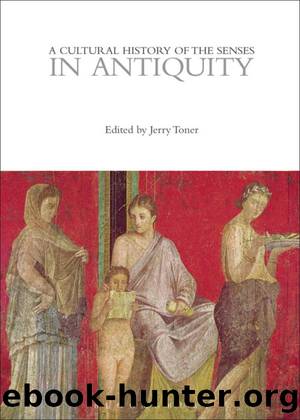A Cultural History of the Senses in Antiquity by Toner Jerry;

Author:Toner, Jerry; [Toner, Jerry]
Language: eng
Format: epub
Publisher: Bloomsbury Publishing Plc
Published: 2014-09-17T16:00:00+00:00
it would be a very strange thing if there were a number of senses (aisthÄseis) sitting inside us as if we were Wooden Horses, and there were not some single form, soul or whatever one ought to call it, to which all these convergeâsomething with which, through the senses (dia tÅn aisthÄseÅn), as if they were instruments (organa), we perceive all that is perceptible.
Platoâs portrayal of the soul (psuchÄ) perceiving âthrough the sensesâ (dia tÅn aisthÄseÅn) recalls the popular model of perception also exploited in the Regimen, where similarly, the soul is affected by perceptions âthroughâ the eyes and the ears (1.35.59). But unlike the schÄmata of the senses in that text, Platoâs use of the word organa here describes the senses not as identified with the physical âsense-organsâ of the body, but rather, in their role as âutilitiesâ of the soul (Burnyeat 1976: 41â2). The implication is that even if perceptions arise from passive affections of the body and necessarily fall short of the status of knowledge, and the senses do not perceive on their own, they can yet be used by the soul actively to ascertain the sensible qualities of things.15
Platoâs fullest treatment of sensible qualities and the mechanics of perception is given in the Timaeus, a text that stands at the end of the grand tradition of Presocratic cosmologizing (it was probably written c. 350s BCE). In response to the challenges of Parmenidesâ Doxa, it presents a âlikelyâ or âprobableâ (eikÅs) creation account that, within the constraints of Platonic metaphysics, redeems the value of cosmology, and the world of perceptibles that it describes, as a likeness of intelligible reality (Bryan 2012: 174â5). Its account of perception is physicalist: perceptions are engendered when âaffectionsâ (pathÄmata) caused by objects impinging upon the body from outside are transmitted through a receptive sense-organ to the mortal part of the Timaeusâ tripartite soul (on Platoâs pathÄmata, see OâBrien 1984: 124â43). Sound, for instance, is defined as âa stroke transmitted through the ears, by the action of the air upon the brain and the blood, and reaching to the (sc. rational) soulâ; and âhearingâ is therefore âthe motion caused thereby, which begins in the head, and ends about the seat of the liverâ where the non-rational mortal part of the soul in charge of perception resides (67b). Of the three other senses Timaeus theorizes (sight, smell, taste), sight is unique because its organ is said to contribute to this physical process by emitting a visual ray (sight, the most active of Platoâs senses, provides the model for intellection, see Nightingale 2004). It is when this ray meets a stream of light whose structure is complementary to it and both coalesce that external âmovementsâ (kinÄseis) are transmitted to the soul and the sensation (aisthÄsis) called âseeingâ (horan) occurs (45bâd). In parallel to the Theaetetus, Timaeusâ account of sensible qualities, in turn, stresses that what is actually seen, the perceptible, is itself merely a product of the physical interaction of the sense-organ and the elemental properties of the object.
Download
This site does not store any files on its server. We only index and link to content provided by other sites. Please contact the content providers to delete copyright contents if any and email us, we'll remove relevant links or contents immediately.
| Africa | Americas |
| Arctic & Antarctica | Asia |
| Australia & Oceania | Europe |
| Middle East | Russia |
| United States | World |
| Ancient Civilizations | Military |
| Historical Study & Educational Resources |
The Daily Stoic by Holiday Ryan & Hanselman Stephen(2709)
The Fate of Rome: Climate, Disease, and the End of an Empire (The Princeton History of the Ancient World) by Kyle Harper(2436)
People of the Earth: An Introduction to World Prehistory by Dr. Brian Fagan & Nadia Durrani(2346)
Ancient Worlds by Michael Scott(2104)
Babylon's Ark by Lawrence Anthony(2070)
Foreign Devils on the Silk Road: The Search for the Lost Treasures of Central Asia by Peter Hopkirk(2056)
India's Ancient Past by R.S. Sharma(1988)
MOSES THE EGYPTIAN by Jan Assmann(1973)
The Complete Dead Sea Scrolls in English (7th Edition) (Penguin Classics) by Geza Vermes(1842)
Lost Technologies of Ancient Egypt by Christopher Dunn(1798)
The Daily Stoic by Ryan Holiday & Stephen Hanselman(1770)
The Earth Chronicles Handbook by Zecharia Sitchin(1744)
24 Hours in Ancient Rome by Philip Matyszak(1678)
Alexander the Great by Philip Freeman(1650)
Aztec by Gary Jennings(1545)
The Nine Waves of Creation by Carl Johan Calleman(1520)
Curse Tablets and Binding Spells from the Ancient World by Gager John G.;(1510)
Before Atlantis by Frank Joseph(1484)
Earthmare: The Lost Book of Wars by Cergat(1469)
